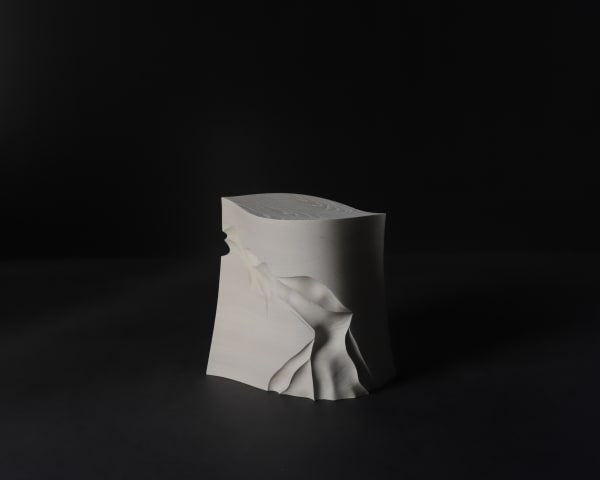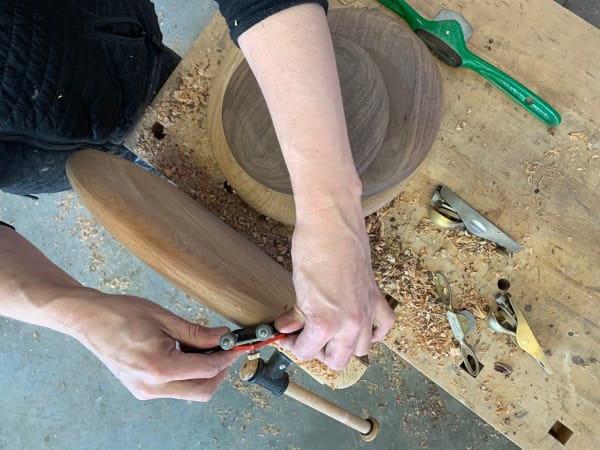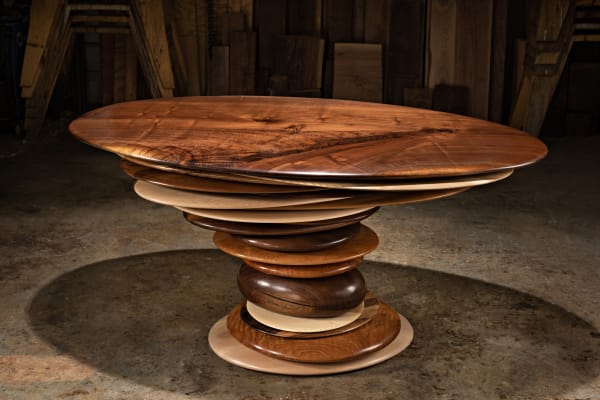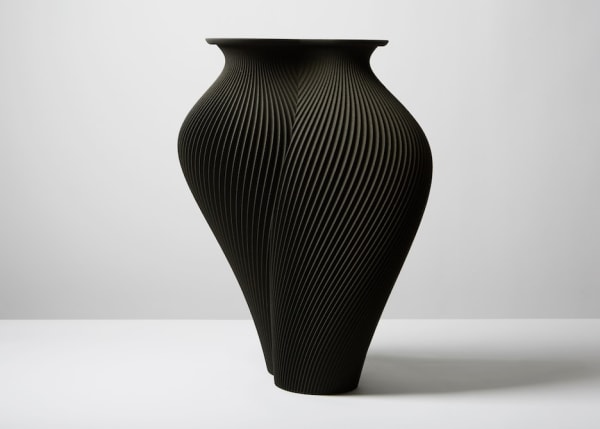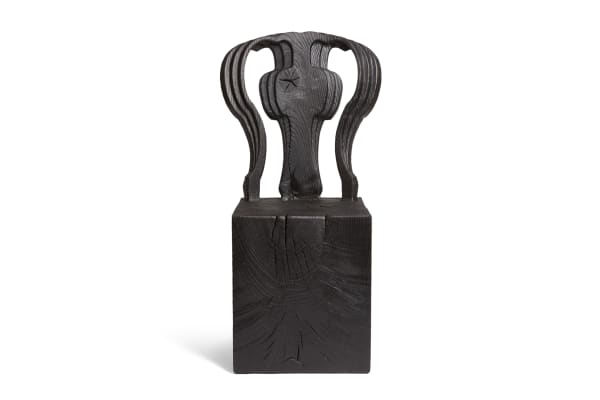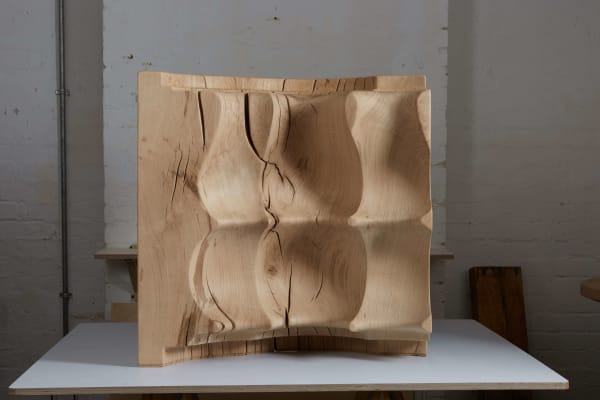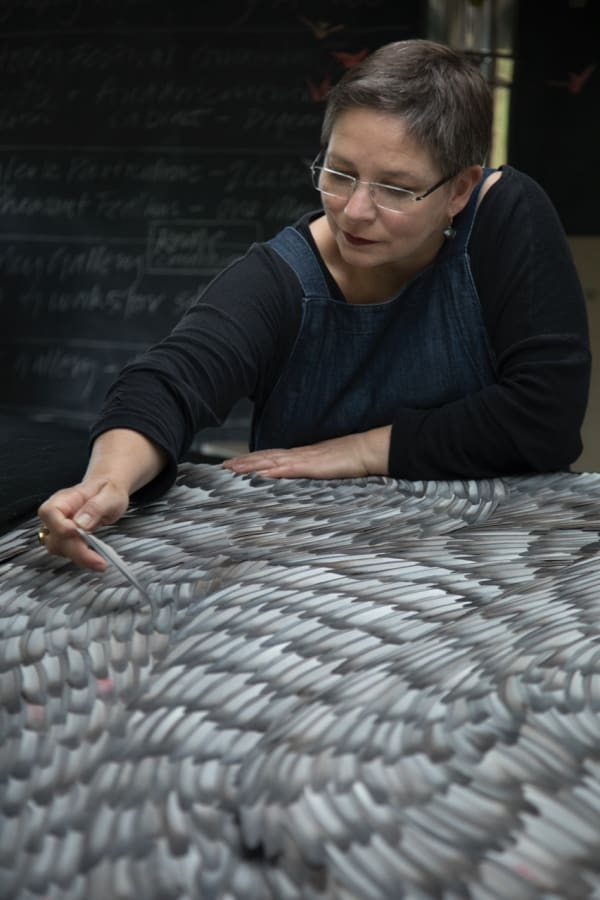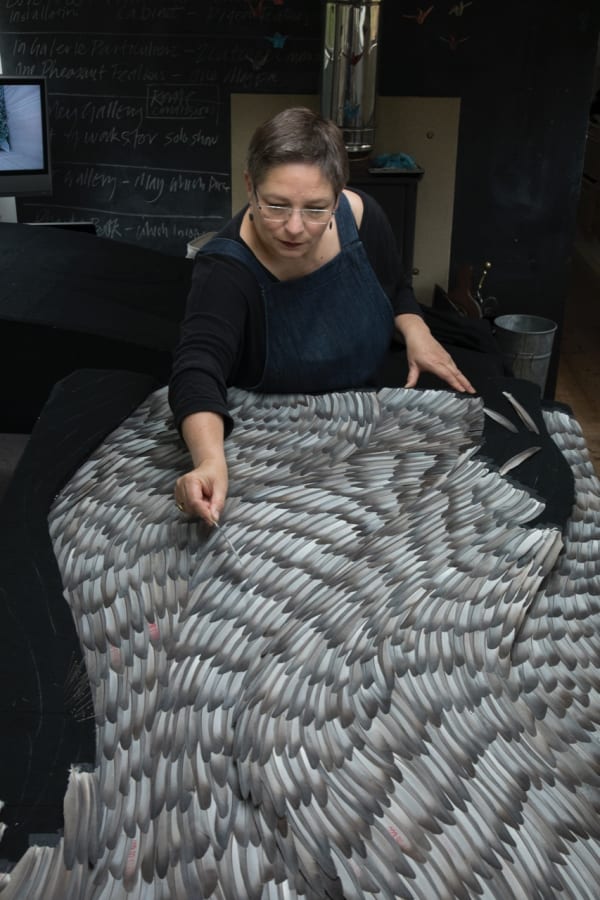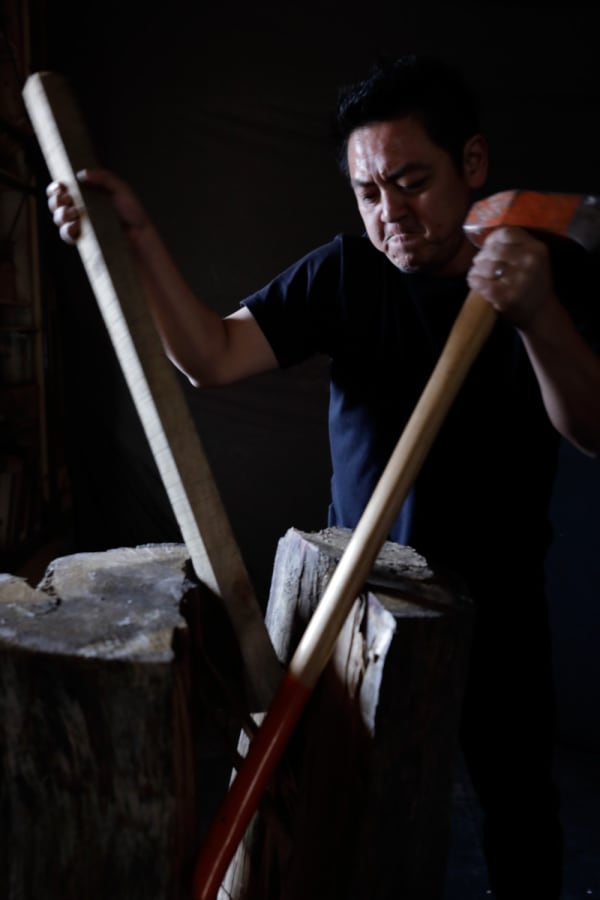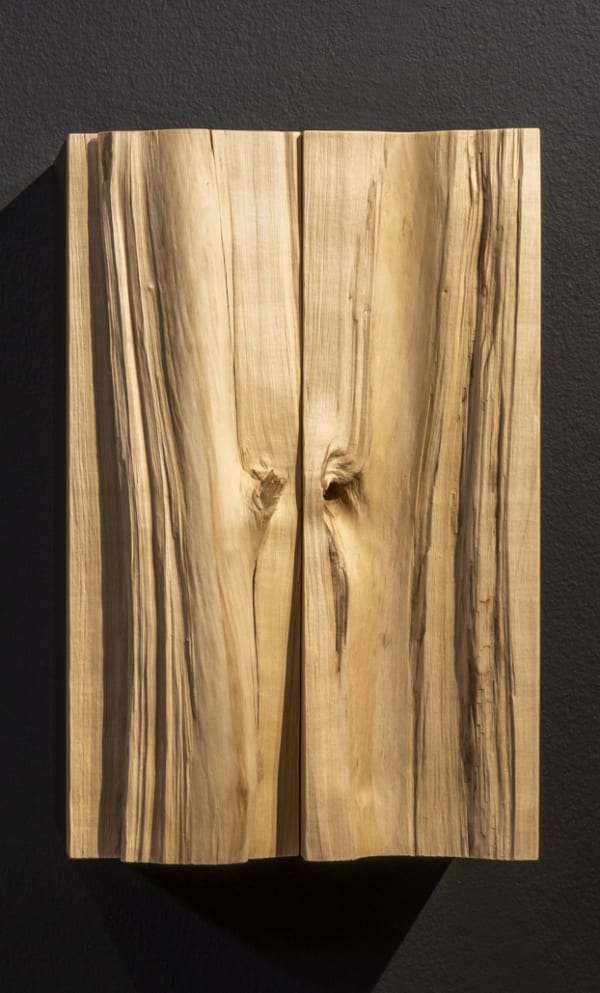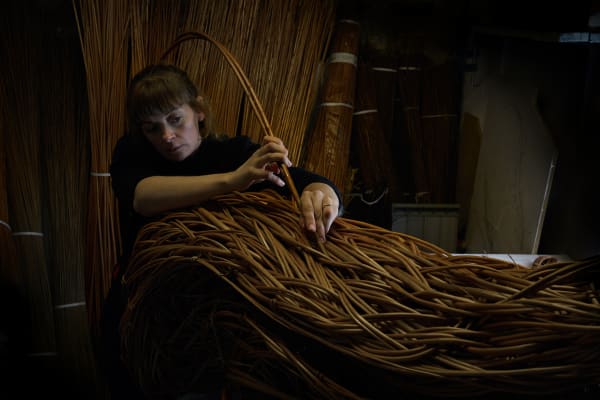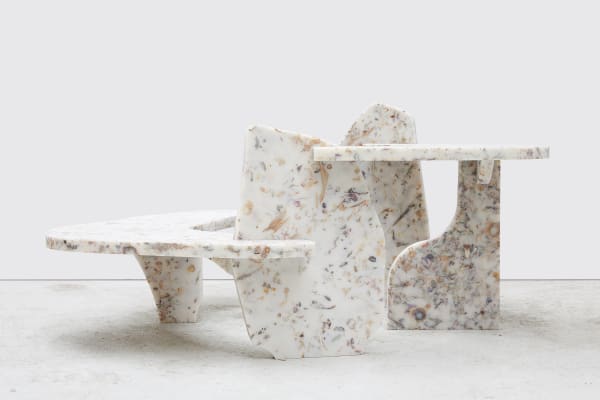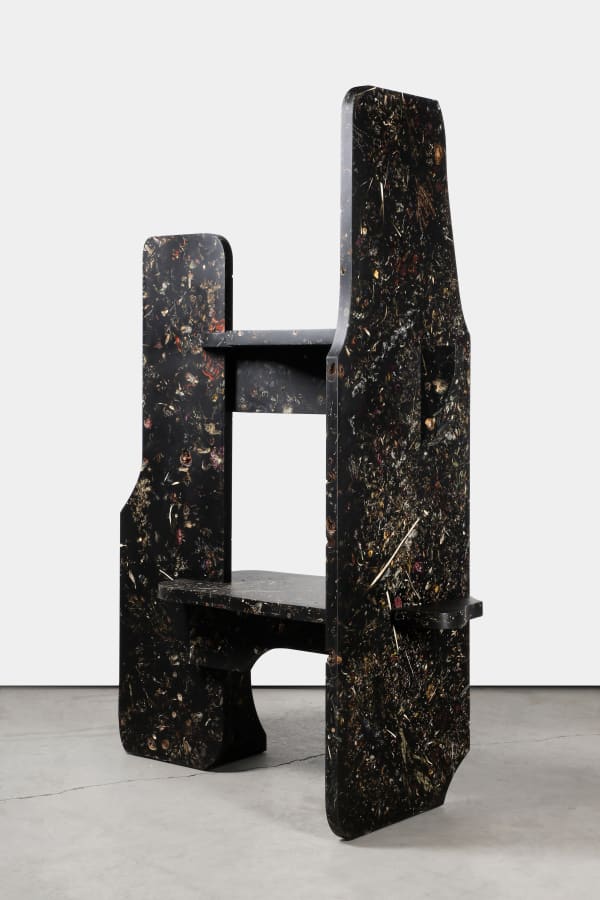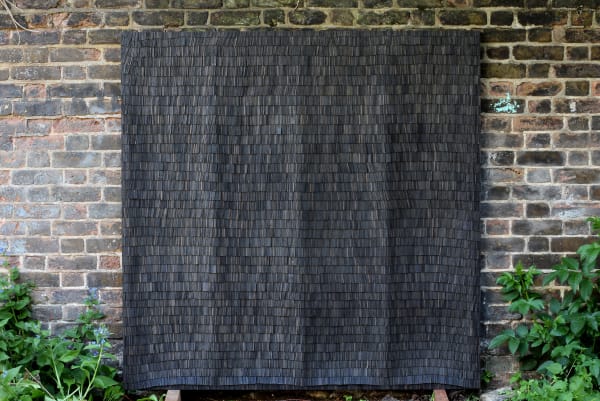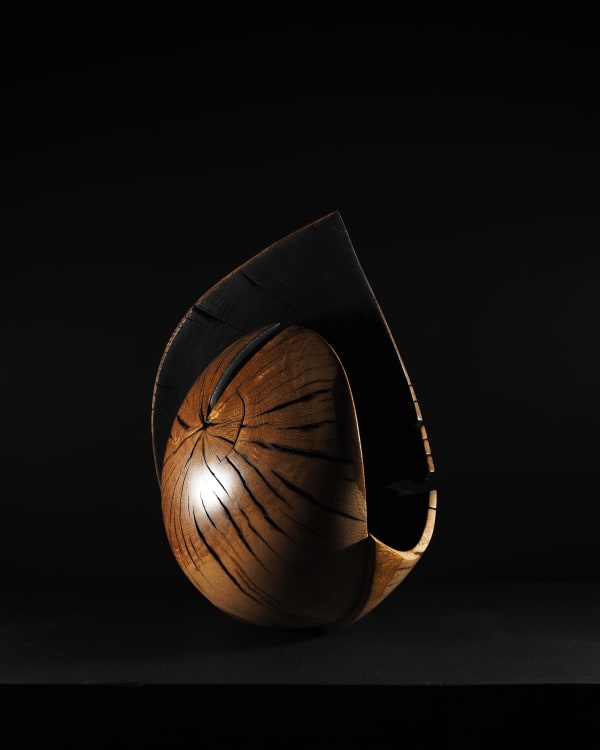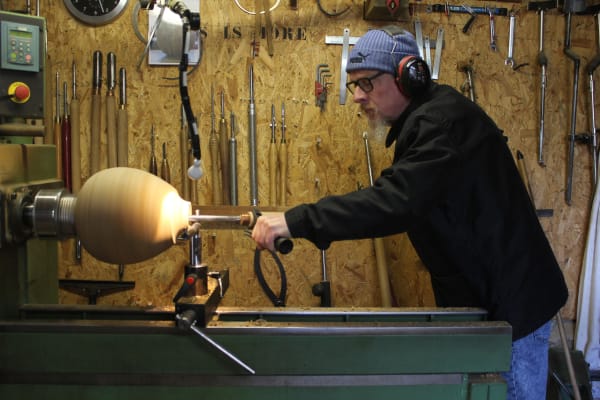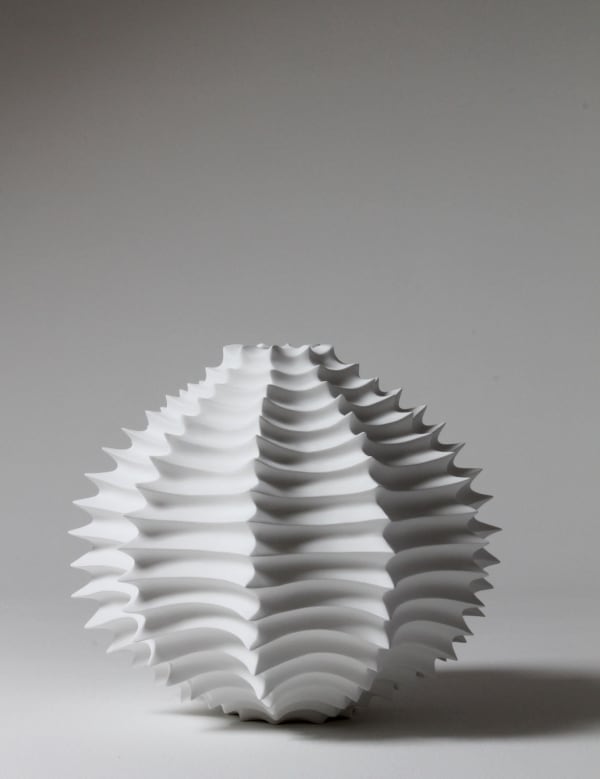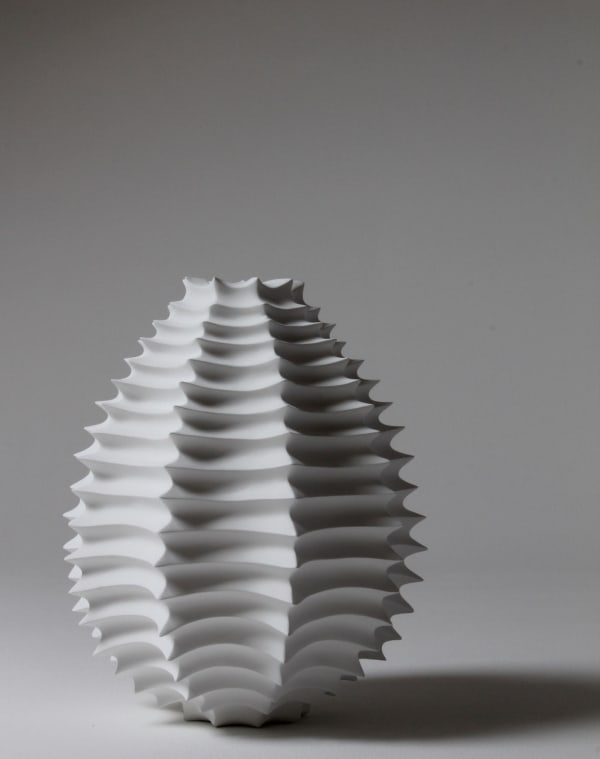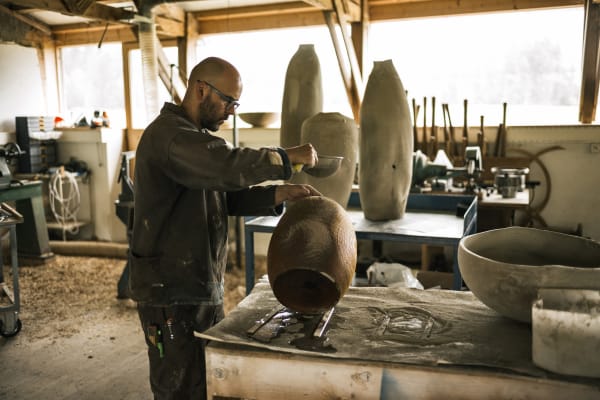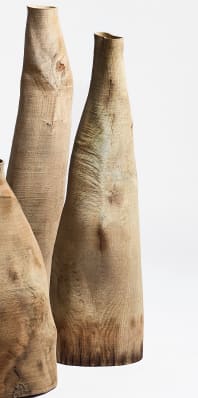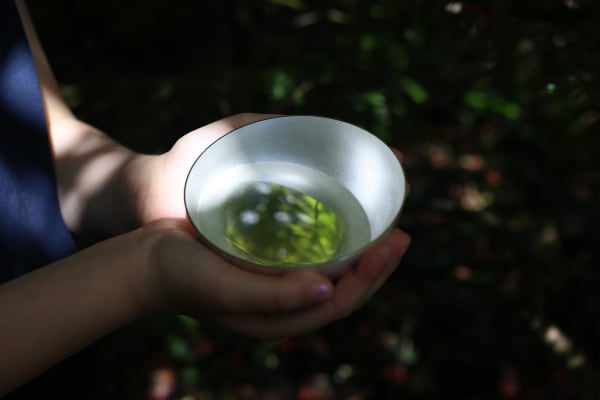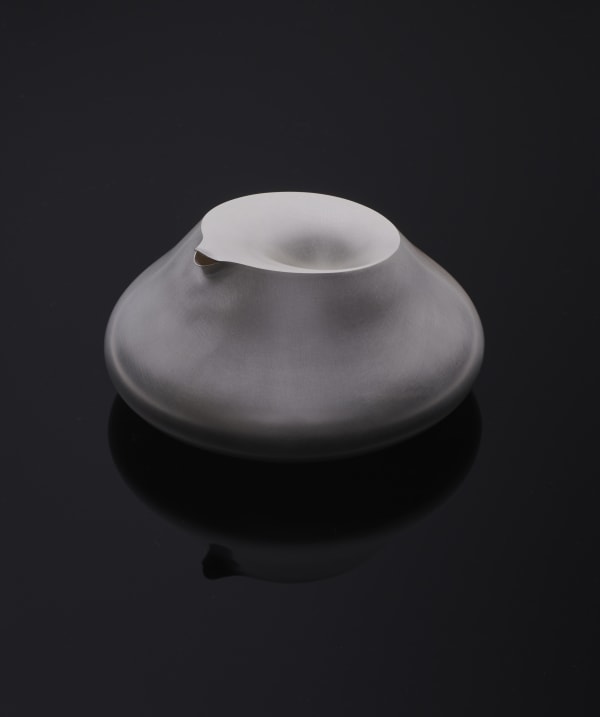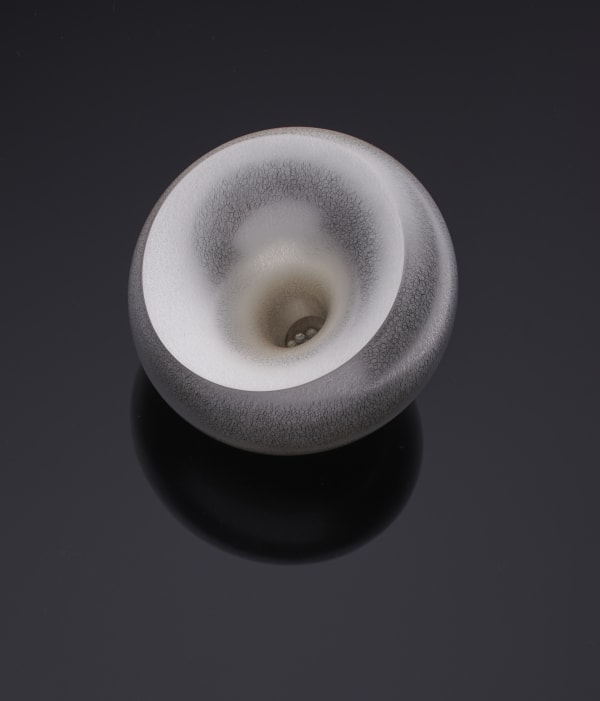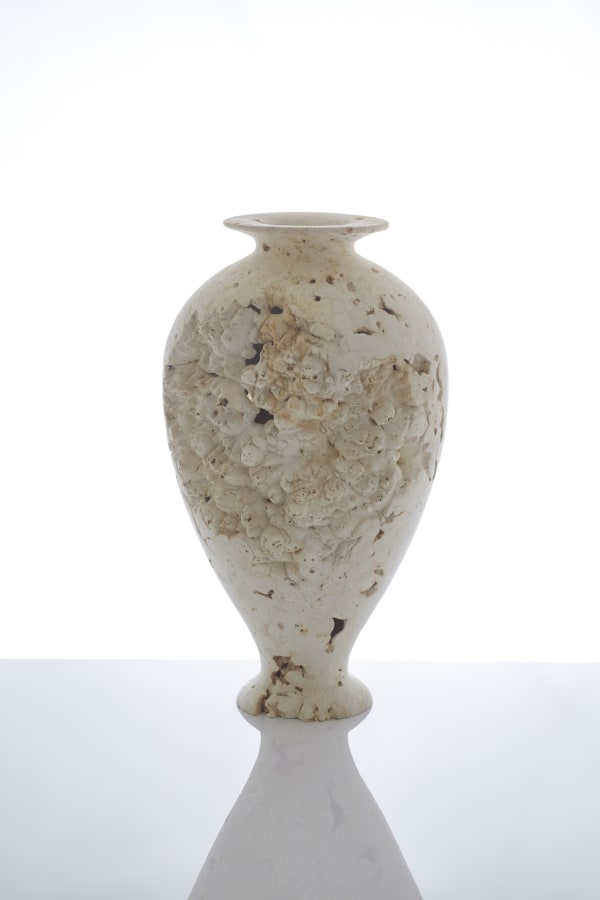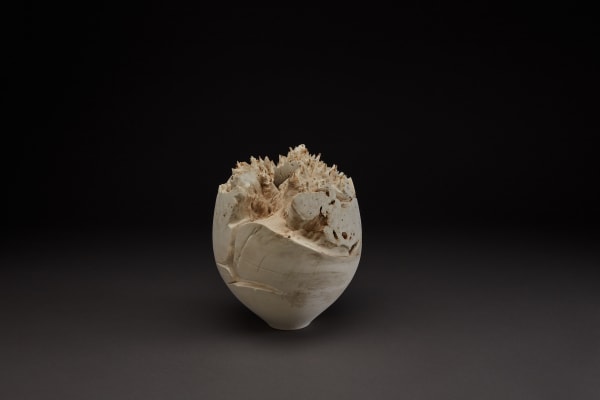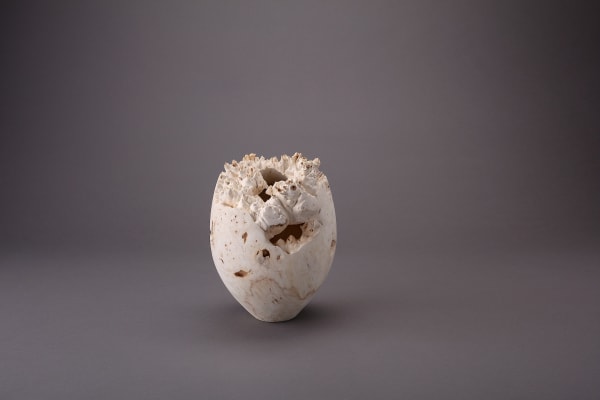Welcome to our Masterpiece London 2020 Viewing Room. We are delighted to be part of the online showcase in association with Artsy. As part of this we are presenting selected collections and objects by our gallery artists. Below you will find information and images about the artists and their unique pieces.
To download these artworks as a PDF, click here.
-
Egeværk
Ice Series -
Ice Series
Mette Bentzen and Lasse Kristensen, known collectively as Egeværk, create meticulously made sculptural pieces, while drawing on craft traditions dating back generations in Danish fine furniture. The ICE series, a significant design project initiated with the gallery in 2019, is the result of a major body of practical research and design development. The concept originated from Egeværk’s deep-rooted connection to the landscape in their native homeland and neighbouring countries, specifically the harsh winter icescapes of Denmark, Sweden and Norway. The artists sought to capture the fluid aesthetics of ice in their opposingly solid medium of Danish Ash wood.
‘A strong wind at the coming of winter had caused wavy patterns in several layers on one side of a puddle – almost like a delicate frill… complex and breathtakingly poetic, microcosmos are a thing of great beauty. Poetry in stopped motion.’ - Egeværk
Kristensen (1985) and Bentzen (1978) were both trained at the esteemed PP Furniture, a Danish joinery established in 1953 and famous for its large portfolio of modern Danish furniture. They are the recipients of a number of prestigious awards and accolades, including the 2019 Snedkerprisen (the Danish Carpentry Award). Most recently, their work has been selected for the Danish Pavilion in Tokyo during the Olympic Games 2020.
-
-
Christopher Kurtz
Skipping Stone Collection -
Skipping Stone Collection
Christopher Kurtz’s pieces are born, first and foremost, from a sculptural motivation invested in the specificity of objecthood; he comments that, ‘for me, making sculpture is not a conceptual or immaterial practice, it’s physical. I settled on wood as my medium because it’s structural, but also malleable and alive.’ The artist expertly sculpts his material using a carefully chosen palette of tools; often beginning without a predetermined blueprint for the final piece, Christopher works intuitively to create poignant and poetic forms that respond to a personal narrative or reflection and which, in turn, elicit a powerful emotional response from the viewer.
Inspiration for Christopher’s Skipping Stone series, specially created for the gallery, comes from his treasured time skipping stones with his daughter on the Hudson River: ‘It's a way we end each day together. We love searching for the perfect river stone; the shapes are so beautiful to hold - sometimes we can't bear to toss the good ones into the river, and we end up putting them in our pockets, bringing them home and stacking them up’. He uses locally sourced wood such as black American walnut, ash, cherry and white oak and sensitively hand carves each piece into smooth elliptical pebble shapes, expressively balanced to form the structure of the work.
-
Gareth Neal
SiO2 Vessels, Block III & Hack Chair -
SiO2 Vessels, Block III & Hack Chair
Gareth Neal’s pieces are concerned with the dialogue between historical and contemporary design. He comments that he is, ‘fascinated by process, whether that be with traditional tools or the latest computer-controlled router. This, combined with an in-depth knowledge of historical techniques and aesthetics, gives [my] designs rich narratives and contextual reference points, while continually testing the limits of craft and design.’ The artist combines 3D computer drawing, CNC processes and 3D printing with the intricacy of professional craftsmanship to create his sculptural pieces. His practice also champions sustainable methods of making and engages in carefully considered material choices. Gareth’s innovative approach to making provides a critical framework for his ideas, as the designs develop into new and diverse territory.
Gareth graduated from Buckinghamshire University in 1996 with a BA Honours in Furniture Design and Craftsmanship. His work has received critical acclaim and has featured in numerous publications and exhibitions, both in the UK and internationally. Gareth has pieces in the public collections of the Victoria & Albert Museum, UK; Crafts Council, UK; and Manchester Metropolitan, UK. His work was exhibited in Against the Grain: Wood in Contemporary Art, Craft and Design at the Museum of Arts and Design, USA; Telling Tales and Power of Making at Victoria & Albert Museum, UK; and The State of Things at The Design Museum Holon, Israel.
-
Kate MccGwire
Feather Wall Pieces -
Feather Wall Pieces
Kate MccGwire works in the specialist natural medium of feathers. The artist grew up in the Norfolk Broads, the daughter of a boat builder, and established her connection to birds and nature early on. When she purchased a barge as a studio on the River Thames, she discovered a colony of pigeons living in a neighbouring warehouse and was inspired to collect and experiment with their feathers in her work. Kate now partners with a small network of British farmers, gamekeepers and pigeon racers to sustainably source her collection of discarded moults; she meticulously catalogues and archives hundreds of feathers by size, colour and pattern in her studio every year.
When making her wall pieces, Kate rhythmically arranges the feathers by hand in concentric and linear patterns, inspired by the movement of water surrounding her studio barge. She highlights their intricately nuanced and magnetic colours, alongside the aesthetic and sculptural possibilities inherent in the material.
Since graduating from the Royal College of Art in 2004, Kate’s work has been exhibited in international exhibitions and museums, including at the Saatchi Gallery, UK; the Museum of Arts and Design, USA; the Musée de la Chasse et de la Nature, France; Muséum National d’Histoire Naturelle, France; and the Gewerbemuseum Winterthur, Switzerland. Harewood House (UK) are holding a major solo show of her work in 2020 and in 2018, she had a significant retrospective exhibition at The Harley Gallery, UK.
-
Peter Marigold & Tadanori Tozawa
Cleft Cabinets -
Cleft Cabinets
Peter’s Cleft series is a collaboration with Japanese master craftsmen, Hinoki Kougei. They first partnered in 2012 for the Japan Creative project at Salone di Mobili in Milan, which brought together Western designers and Japanese craft artisans. Chuzo Tozawa, founder of Hinoki Kougei, proposed they use gigantic split logs to form the sides of their Dodai bench, finished with a covering made from handwoven igusa (rush grass). The resulting piece shifts between gestural sculpture and functional bench and invites us to engage in a rich sensory experience; the cleft planes where the wood has been pulled apart and sanded back are highly tactile, coupled with the appealing organic aromas of Japanese Cypress and igusa grass. Peter’s partnership with Hinoki Kougei has continued in his collaborative project with Chuzo Tozawa’s son, Tadanori Tozawa. Their series of wall cabinets gives a frontal focus to the dramatic cleaving action. Based on the form of traditional medicine cabinets, these pieces are made from different woods, each carefully selected for their special qualities that are accentuated in the clefting process.
-
Laura Ellen Bacon
Willow Bench -
Willow Bench
‘I use natural materials, en masse. I hope my language of form may feel strangely familiar to the natural world. It is my goal that my work might bring some intrigue into both natural and built environments, creating work that might serve to remind us that nature can still surprise us.’
Laura Ellen Bacon works with sustainably grown Somerset willow and has developed her own language of tying and interlacing soaked strands of the material to construct biomorphic forms that feel strangely familiar. Laura’s immersive and physically demanding process of making is normally performance and installation based, meaning that her organic bench form represents the beginnings of an entirely new direction in her practice.
Laura’s large-scale works have been included in exhibitions at the Ruthin Arts Centre, Wales; Holburne Museum, Bath; New Art Centre, Wiltshire; Sudeley Castle (Sotheby’s installation); Derby Museum and Art Gallery; and Blackwell – The Arts and Crafts House in Cumbria. In 2017 she was a finalist within the Woman’s Hour Craft Prize at the Victoria & Albert Museum, London and in 2010 she was selected as a Jerwood Contemporary Maker. In 2018 her work inspired the composer Helen Grime, whose resulting three-part movement, ‘Woven Space’ was performed at the Barbican by the London Symphony Orchestra, conducted by Sir Simon Rattle.
-
Marcin Rusak
White Perma Collection -
White Perma Collection
-
White Perma Collection
His innovative furniture-sculptures are made using the excess accumulated by florists; the discarded flowers are given a new life cycle by becoming the very essence of the material. He raises questions about consumerism and waste engendered by global flower markets; and, in turn, highlights the origin of materials and possibilities for their futures by making use of recycling practices. Marcin also mines our perceptions of beauty and its transience; the petals, stems and buds encased within the Perma material appear like veins in marble or cavities in fossilised stones and create an unexpected array of colour combinations and painterly effects. These elements are completely stable within the material and will last a lifetime. The Perma collection also incorporates references to cultural and personal histories; not only does Marcin recall - and revitalise - our long obsession with flower motifs in furniture decoration, the designer also recalls his own family history: he is the son and grandson of flower growers and preserving this heritage is an essential part of his practice.
-
Wycliffe Stutchbury
Shingled Screen and Wall Panel -
Shingled Screen and Wall Panel
Wycliffe Stutchbury respects his material as an elemental record of the British Isles’ natural history. His ambitious wall panels and standing screens are inspired by the countryside he has experienced and lived in over his lifetime; from the Fenlands of East Anglia to the South Downs, where the artist spent his earliest days. This childhood relationship to woodland means he has an intrinsically close bond to his material: holly bush, oak and bogwood express his emotional connection to his subject while acting as an index of place itself. For Wycliffe, the finished piece is always an exploration of landscape: field, furrow and fall line are all embedded in the undulating scenery his work recalls.
His making process is slow and meditative; delicately hewn tiles of wood are placed by hand to create abstract compositions that are at once emotive, intuitive and conceptual. Patterns emerge in linear forms and subtle tonal changes susurrate across the picture's surface - reminding us of the wood’s creation and guiding us back to place.
The artist has exhibited extensively in the UK and the US and has significant works in international private collections. He has received several notable awards, including from the Crafts Council UK and the Worshipful Company of Furniture Makers UK. In 2018, Wycliffe was shortlisted for the Loewe Craft Prize.
-
Nic Webb
Hand carved vessels -
Hand Carved Vessels
Nic Webb carves, scorches, burns, soaks and stains different species of fallen wood to create pieces that explore the natural drama of the material. He responds in a spontaneous, personal way to the individual character of each piece of wood, using intuitive processes to work in dialogue with the timber’s imperfections. He encourages cracks and splits to express themselves on the surface and contrasts areas of natural grain with highly polished smooth exteriors. The artist plays, too, with myriad shapes and forms - classical fluted vessels that swoop in graceful curves; mountainous rugged edges, or undulating dips and folds; and abrupt, angular pieces that openly reveal the artist’s sculpting hand.
To achieve his powerful works, Nic uses traditional tools, modern methods as well as experimental forms of carving; he explores the natural elements of ice, water and principally fire to shape his work in an unbound and organic manner. Webb comments that, ‘as fire journeys into wood, forms are revealed, briefly seen and quickly disappear. These vessels begin in primitive crudeness, move through varying states of function, and evolve or ‘devolve’ towards a delicate border between existence and absence. On the whole, the fire and the wood burn as they wish. As the piece concludes, I intervene, shepherd and finally halt the progress of loss at the place before all remnants of the journey are gone.’
After studying Fine Art at the University of Brighton, Nic spent several years in Cypress before returning to London to work as a set builder. His studio is now based in the coastal region of East Sussex, UK. His work is at the forefront of British craft and has been exhibited extensively in the UK, as well as in the USA. He has pieces in significant international private collections across the world.
-
Marc Ricourt
Hand carved organic vessels -
Hand Carved Organic Vessels
Marc Ricourt draws his inspiration from the ancient utilitarian object of the vessel. He comments that, ‘I’ve based my work around a simple but very essential object, as it was the first tool created and used by mankind… My work on vessels has allowed me to develop a relationship between ancient or geographically remote cultures and civilizations and modern creations. The most important facet of my work is the research and exploration of new forms, colours, textures and finishes.’
Marc sources the wood he uses from his local landscape in Dijon, France. He initially turns on a traditional lathe and then intricately carves and treats the surfaces through bleaching, dying or an application of ferrous oxide, to explore the vessel through organic shapes that often recall seedpods and the undulating edges of leaves, carved as delicate linear fins. Historically, Marc has worked with green wood and followed the grain of the timber to achieve the perfect form. Recently, however, he has been experimenting with dried out, timeworn wood taken from the heart of the tree, to create highly textured rugged surfaces that heighten the sculptural aspect of his work.
Marc has exhibited extensively in the UK and internationally. His work is placed in significant private and public collections, including Musée des Pays de L'Ain, France; the Wood Turning Center, UK; The Center for Art in Wood, USA;and the ASU Art Museum, Tempe, USA. He has been shortlisted for the Loewe Craft Prize 2020.
-
Ernst Gamperl
Turned sculptural vessels -
Turned Sculptural Vessels
Master craftsman Ernst Gamperl has revolutionised the practice of wood turning by developing entirely new modes of working that push it to its technical limits. The artist principally uses the mighty European Oak tree and carefully selects his immense logs from sustainable sources – either from trees that could not stand their ground against the wind or were felled due to decay.
Ernst turns the oak when it’s green and supple, to work in dialogue with the wood before arriving at a final shape; he is an expert in its drying properties and prophetically reads its movement as the sculpture finds its undulating form. The artist eschews uniformity and celebrates the imperfections present in the material, which tell the story of the tree’s momentous life and energy; the curved edges and bulges, the projections and indentations that emerge out of the natural deformation of the wood are an essential part of Ernst’s design. The immanent expressive power of the material is underscored by Ernst’s treatment of the surfaces: waxing and polishing, scrubbing out the streaks or carving filigree parallel grooves like velvet, contrasting smooth and shiny areas with rough-hewn, deeply scarred sections. These enriching elements draw us ever closer to the piece; the profundity of the work lies in Ernst’s ability to mine the emotional resonance that lies within the wood.
Ernst won the first Loewe Craft Prize in 2017 in recognition of his craftsmanship. His work is part of many international collections, including the Victoria & Albert Museum, UK; Fond National d’art Contemporain France; Museé des Arts Décoratifs de la Ville de Lausanne, Switzerland; The International Design Museum/Neue Sammlung, Germany; Collection Issey Miyake, Japan; and Amorepacific Museum of Art, South Korea. His solo museum exhibition, Dialogue with Wood, opened at the Gewerbemuseum Winterthur in Switzerland in 2019 and toured to the Korean Craft Museum in Spring 2020.
-
Adi Toch
Pooled Reflections & Whispering Vessels -
Eleanor Lakelin
Hand Carved Vessels -
Hand Carved Vessels
‘I peel back bark to reveal the organic chaos that can exist in the material itself and build up layers of texture through carving and sandblasting. I use the vessel form and surface pattern to explore the layers and fissures between creation and decay and the erosion of nature.’ – Eleanor Lakelin
A connection to the past is profound in Eleanor Lakelin’s work; she is fascinated by wood as a living, breathing substance with its own history of growth and struggle, centuries beyond our own. Her sculptural objects made in Horse Chestnut are created using a traditional woodworking lathe and centuries-old chisels and gouges, alongside modern tools and carving techniques. Her vessels appear like archaeological objects pulled from the ground; classical forms are referenced and smooth surfaces, reminiscent of ossified matter, rhythmically yield to knotted sections of burr. Engaging in sustainable practices, Eleanor works only with trees grown in Britain and felled due to decay. A deep knowledge and a passionate interest in the natural properties of wood result in forms that seem true to the spirit of the material and which encourage us to look at the complexities of nature with a new perspective.
Eleanor’s work is exhibited internationally and is part of prestigious private and museum collections, including the Victoria & Albert Museum, UK; the Museum of London, UK; and the Mint Museum of Craft and Design, USA. She is the recipient of notable awards and commendations, including a QEST Scholarship in 2018; winner of the Bespoke Category of the British Wood Awards in 2017; nomination for the Perrier-Jouët Arts Salon Prize in 2014; and The Cockpit Arts / Worshipful Company of Turners Award in 2011. -
James Rigler
Unique Press Moulded Ceramic Furniture -
Unique Press Moulded Ceramic Furniture
James Rigler’s distinctive ceramic and metal leaf pieces exist at the intersection of pure sculpture and functional furniture. Their bold forms are inspired by elements of architectural ornamentation, found in monumental and palatial structures. The artist comments that he is, ‘led by thoughts of ruined and abandoned ancient places, romantic landscapes and stage sets.’ Yet, through the use of contemporary details such as metallic colour and exaggerated scale, he removes any standard allusion to these reference points, and creates playful objects that intrigue us in their enigmatic practical and aesthetic intentions.
James is a graduate from the Ceramics and Glass MA at Royal College of Art, UK. In 2013 – 2014, he undertook a six-month ceramics residency at the Victoria and Albert Museum and his work forms part of their permanent collection. He also has works in the permanent collections of the Crafts Council UK, Chatsworth House, UK and Brighton Museum & Art Gallery, UK. He is the recipient of the Grand Prize for New Talent, European Ceramic Context Biennial, Denmark 2014 and the Inches Carr Trust Award 2017. He was a winner of Jerwood Maker’s Open 2012. Additional residencies include; the International Ceramics Research Centre, Guldergaard, Denmark, the Northern Gallery for Contemporary Art, Sunderland, and Cove Park, Scotland. In 2014 he was the recipient of the prestigious European Ceramic Context New Talent Award.





